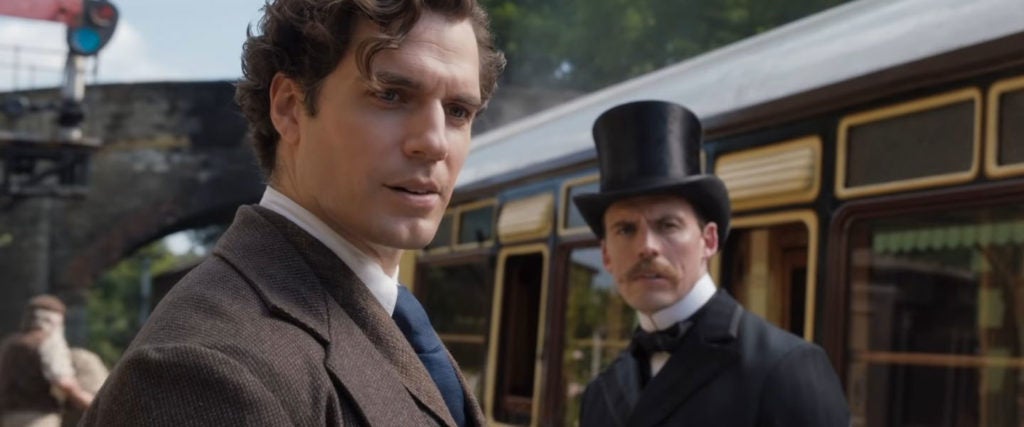Henry Cavill is the latest hunky actor donning a three-piece suit and air of arrogance to become Sherlock Holmes. He stars in the new Netflix film Enola Holmes as the older brother of Enola — a strong-willed 16-year-old budding detective played by Millie Bobby Brown. Sam Claflin as the mustachioed Mycroft is the oldest of the three Holmes children, and Helena Bonham Carter plays their missing mother.
Cavill’s piercing baby blues and well-diffused curls dominate whenever he pops in. His hulking 6-foot-1 Superman body hogs the screen when paired with Brown’s 5-foot-4 frame. It’s a distracting plot hole. The film is not even about him, but now all I want to know is this: When did Sherlock Holmes get so hot?
Is sexy Sherlock even accurate? And, if so, how’d Holmes end up as a detective and not some sort of 1800s version of an Abercrombie & Fitch model? He should be spending his afternoons tearing up the streets of London working on new cases, not lifting dumbbells in the back of the Victorian-era Barry’s Bootcamp. How’s he going to hide in dark alleys and narrow passageways with a trunk like that?
The case of the too-hot Sherlock is afoot.
Here’s what we know. Cavill is, actually, the correct height. Sherlock Holmes creator Arthur Conan Doyle outlined the detective’s physique in the 1887 novel A Study in Scarlet: “Over six feet, but so excessively lean that he seemed considerably taller,” Doyle writes. The star of Man of Steel and The Witcher can pull off a latex suit, loincloth and three-piece ensemble, but he is not a neurotic British lank.
Case closed: Cavill is too burly to be Holmes. Right?
Well, not so fast. As it turns out, not a single depiction of Holmes is accurate. The first official rendering of Holmes appeared in the late 1800s by way of British illustrator Sidney Paget. He first drew Holmes for the short story “A Scandal in Bohemia,” which appeared in the 1891 July issue of The Strand Magazine.
According to Andrew Lycett’s biography of Conan Doyle, The Man Who Created Sherlock, Paget’s Holmes is “an enduring image of a trim figure with sharp, thoughtful features, wearing smart modern clothes, which later in the year, ran to a cape and deerstalker hat.” Okay, so Holmes is giving us Victorian-era James Bond.
But this first depiction wasn’t exactly what Doyle had in mind either. Holmes is a bookish weirdo — he was never supposed to be suave. Doyle addressed prominent renderings of his No. 1 detective in his 1924 autobiography Memories and Adventures, and not a single impersonation or drawing aligned with the author’s vision. “[Holmes] has, as I imagined him, a thin razor-like face, with a great hawks-bill of a nose, and two small eyes, set close together on either side of it,” Doyle wrote. Sounds like Sherlock is supposed to be a literary twink, not the muscle daddy Cavill is today. (Ralph Fiennes, hire a new agent, because you should have played Holmes in Holmes & Watson. Not Will Ferrell.)
Which means Enola Holmes certainly took some creative liberties with its hot Holmes. Cavill’s detective barely communicated with his younger sister for 16 years and didn’t even recognize her upon reconnecting, like a 19th-century hustler asshole too focused on his “career.” So, no, this perfectly groomed Holmes is not “accurate,” per se. But is he really that much of a stretch?
“If you think of Sidney Paget’s illustrations, yes, that’s quite far off. But if you look at him next to 100 other actors playing Sherlock Holmes, well, it’s hard to say who is far off,” Swedish Sherlockian Mattias Boström tells me.
Take Benedict Cumberbatch’s Holmes on BBC’s Sherlock. He opted for an angular, wiry Holmes with an affinity for wool scarves and disheveled curly hair. “Benedict Cumberbatch is more accurate, but still quite far off from the traditional appearance,” Boström says. If Cavill is the bro Sherlock, then Cumberbatch is the eBoy: insufferably cynical and probably a bad tipper.
Both are a stark contrast to Robert Downey Jr.’s take on the character. RDJ played the detective in a 2009 film and its 2011 sequel. Downey drew on his own tumultuous past to play a disheveled Holmes who’s prone to drunken boxing matches. (Keep in mind this was RDJ’s career redemption era, so his drunken detective was a turn-on, not a red flag.)
None of these three Sherlocks fit Doyle’s original image, which has garnered debate on how Sherlock should be portrayed among actors who’ve assumed the role. Shakespearean stage actor Basil Rathbone played the sleuth in 14 Hollywood films in the early 1940s. A young Ronald Howard (no, not the A Beautiful Mind director) played Holmes in a 1954 TV show. Rathbone reportedly said he never considered Holmes as a young man, although that’s Doyle’s original depiction.
There’s also Welsh actor Clive Merrison’s long-running portrayal on BBC Radio, and, more recently, Jonny Lee Miller on CBS’s Elementary, among many more interpretations. Nearly all of them come with some sort of physical imperfection — like disheveled clothes, weathered skin or gaunt cheeks — to hint at Holmes’ most confounding mystery: his own sanity.
Having Cavill — the epitome of physical perfection and the most All-American superhero — play a neurotic British introvert poses more questions than answers. “You’re telling me he’s Sherlock Holmes, but Sherlock is a straight-up weirdo?” questions author and Sherlockian Dana Schwartz. “Cavill reads as a large, imposing jock. You can’t have everything, Henry Cavill.”
Time and again, hot people receive concessions for bad behavior, and in Enola, Cavill cosplaying as caked-up Sherlock lets him get away with being a shitty older brother. The actor is brooding when he’s supposed to be brute. He’s guarded when called to be dismissive. It’s hard to think of him as the evil older brother when you just want to jump into his chiseled, beefy arms.

